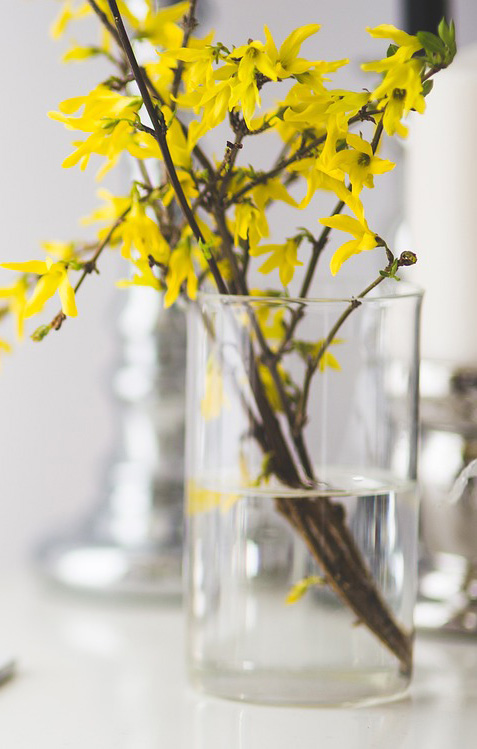
Winter days may be gloomy and dull, but you can give your home a touch of spring by forcing landscape branches to bloom indoors. Spring-flowering trees and shrubs set their flower buds the previous fall. Once the buds have been exposed to cold for several months (usually by mid-January), branches can be cut and forced to bloom early indoors - giving you the opportunity to enjoy a touch of spring.
 Good Candidates
Good Candidates
The easiest branches to force include apple/crabapple, cherry, dogwood, flowering quince, forsythia, honeysuckle, magnolia, pear, pussy willow, redbud, serviceberry and witch hazel. Dainty apple blossoms, like those at right, bring a touch of spring indoors.
Generally, shrub branches are easier to force than tree branches. Tree flowers are often less showy than those found on the plants mentioned above, but that doesn't mean you can't enjoy blooming branches harvested from maple or oak for their subtle beauty.
Buds take from one to five weeks to open, depending on the plant you choose and how close to the natural blooming time they are harvested. The closer to spring, the shorter the wait for flowers.
Choosing Branches
Carefully prune out the branches you need, taking care not to injure the plant or ruin its shape. Cut each branch just above an outward pointing side bud, being careful not to leave a stub. Take branches from crowded spots or other areas where they will not be missed and select healthy branches, free from disease, insect and other injury.
The length of the cut branch can vary, but between 6 and 18 inches is a good length. Look for branches with many flower buds – they are usually larger and fatter than leaf buds. Cut teach stem with a sharp knife or pruners.
Stem Care
Once the branches have been cut, bring them indoors. If possible, totally submerge the branches in room temperature water overnight. A wash tub or bathtub works well for this. Soaking allows the branches and buds to absorb water and begin to break dormancy. The next day, place the branches in a bucket of water, cut stem end down.
If submersion is not possible, then place the stem ends in water immediately. Ideally, the stems ends should be recut, to create a fresh opening that will absorb water as quickly as possible, before placing them in water. (This eliminates any water-absorbing cells already blocked with air bubbles.) Mist the branches frequently for the first few days. A piece of damp burlap can be wrapped around the branches to help maintain high humidity.
After soaking or spraying, the branches are ready for forcing. Place them in a relatively cool area, 60-65 degrees F, and change the water every few days. Bacteria grow quickly in water and will shorten the life of the stems.
Higher temperatures will cause the buds to develop too rapidly, and the flower size, color and quality will be sacrificed. Maintain high humidity as the flower buds develop, otherwise they may dry off and fall.
Branches need light for forcing, but not direct sunlight. Heat from direct sun is too intense. Keep in mind the cloudy, raining conditions naturally occurring when these plants bloom and find a bright indirect sunlight location for best flower development.
Using Branches Indoors
When the flower buds are well developed and showing color, bring them into your living area and arrange them in decorative containers. Arranging the branches at this stage allows you to enjoy their bud color and watch the flowers as they open.
The flowers will last longest if kept in a cool location, 40-60 F night temperatures, away from direct sunlight. Be sure to keep the container filled with water.
Flowering branches may be displayed with other flowers, foliage plants or by themselves for a striking display.